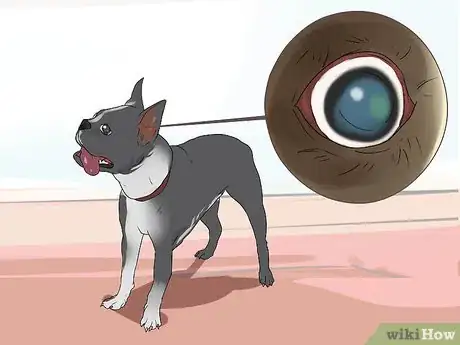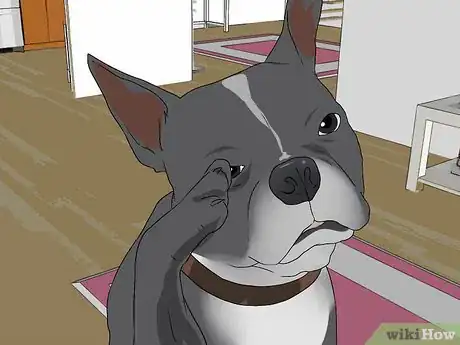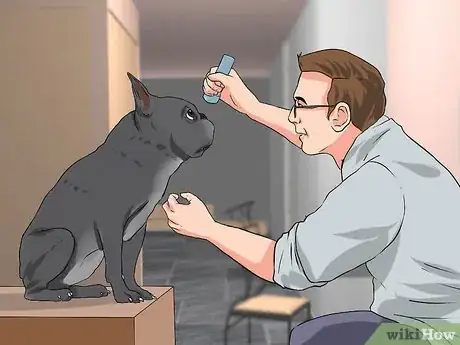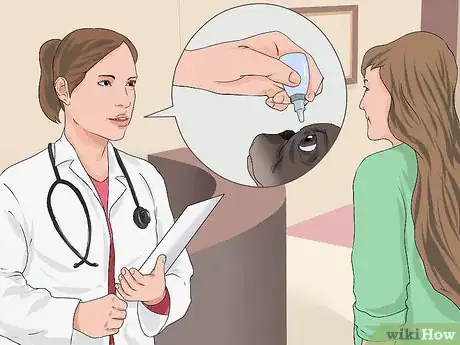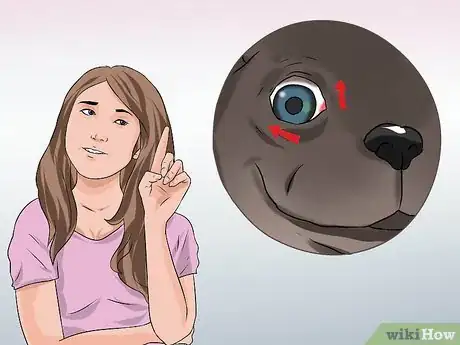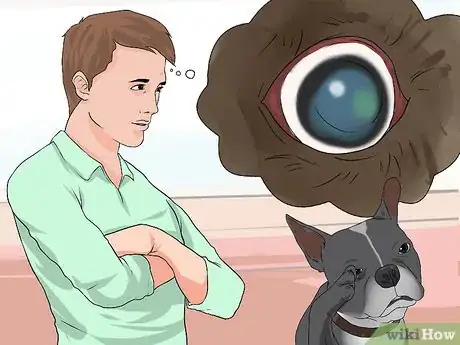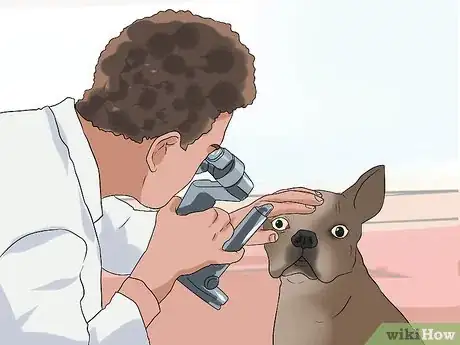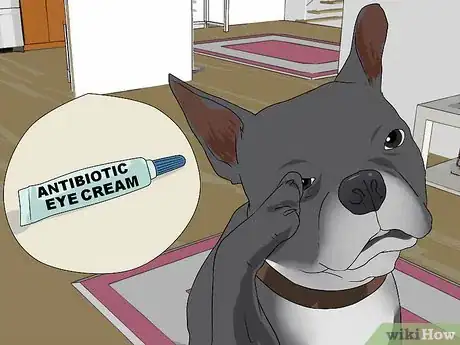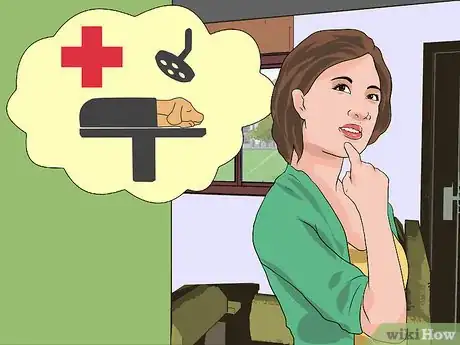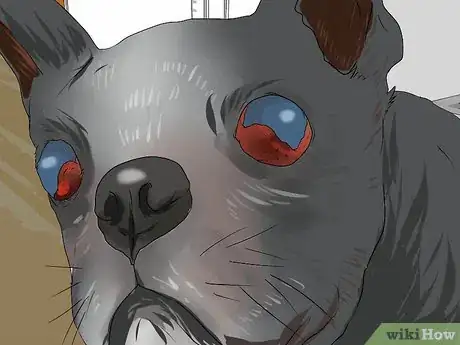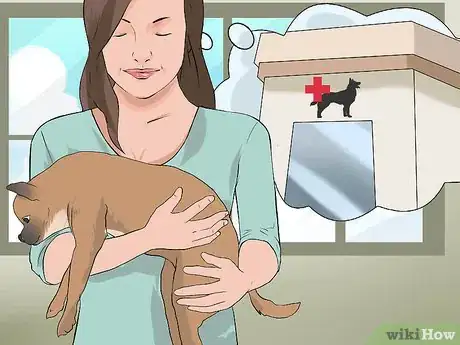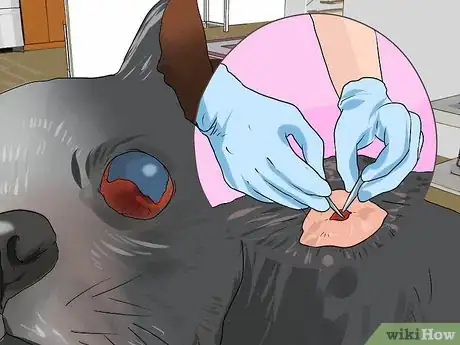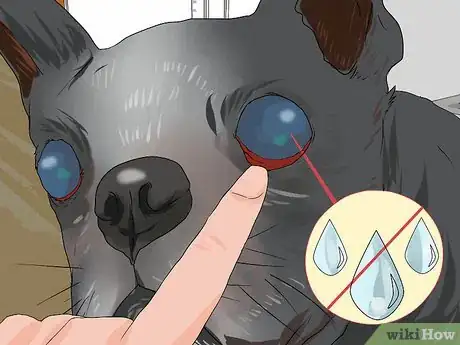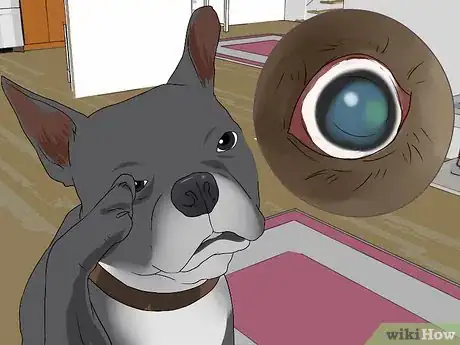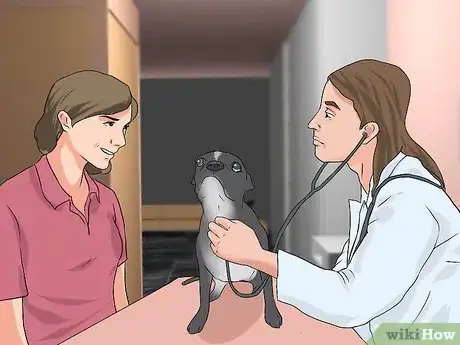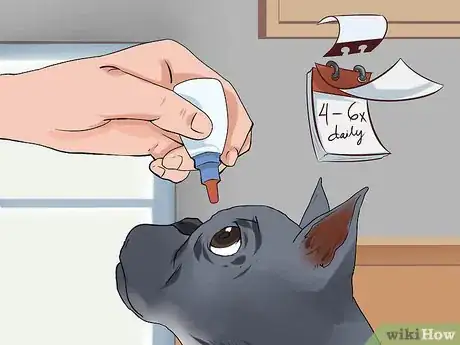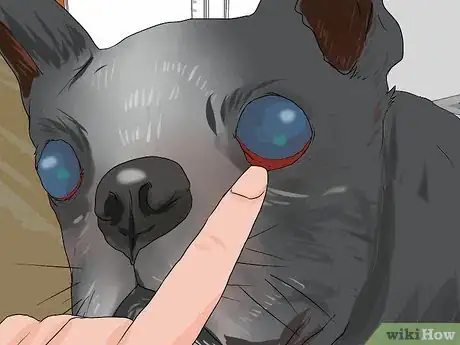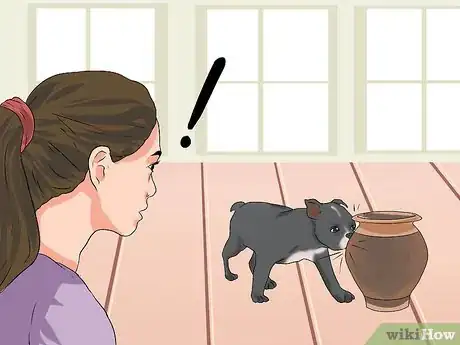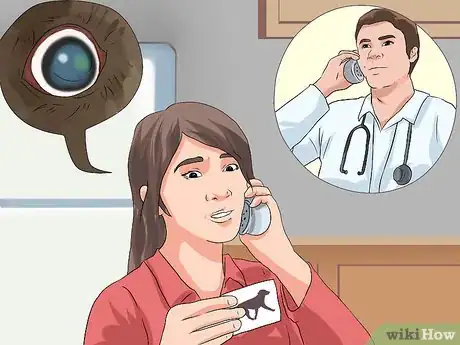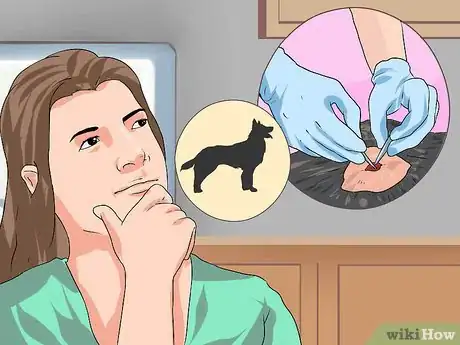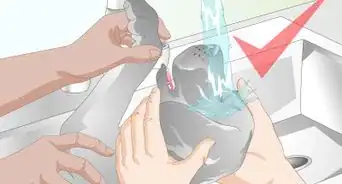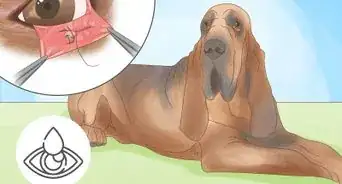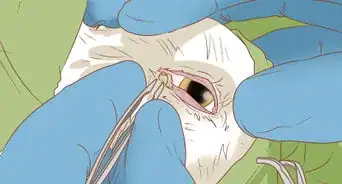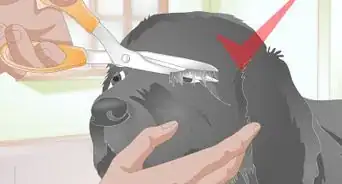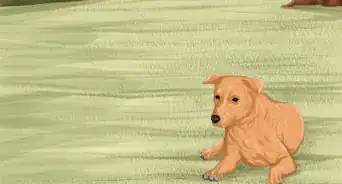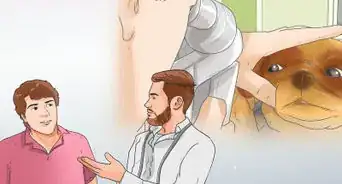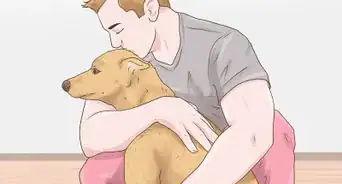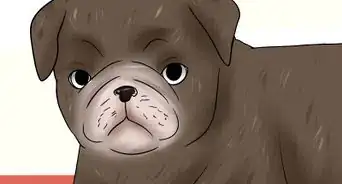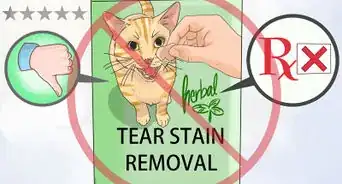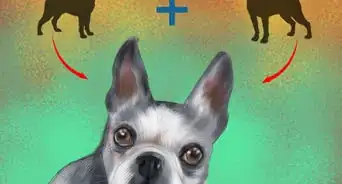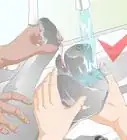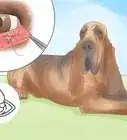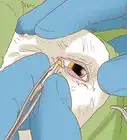This article was co-authored by Pippa Elliott, MRCVS and by wikiHow staff writer, Jessica Gibson. Dr. Elliott, BVMS, MRCVS is a veterinarian with over 30 years of experience in veterinary surgery and companion animal practice. She graduated from the University of Glasgow in 1987 with a degree in veterinary medicine and surgery. She has worked at the same animal clinic in her hometown for over 20 years.
There are 11 references cited in this article, which can be found at the bottom of the page.
This article has been viewed 62,916 times.
If you have a Boston terrier, you probably know how lively and intelligent this popular breed can be. The Boston terrier is easily recognized by his large wide-set eyes. The outside corners of the eye are in line with the cheeks when viewed from the front. Unfortunately, the large size of the eyes can make them more prone to eye problems. Your dog's eyes could become scratched or damaged causing corneal ulceration or your dog may develop cherry eye, early onset cataracts, corneal dystrophy, and dry eye.[1]
Steps
Recognizing and Treating Corneal Ulcers
-
1Watch for signs of a corneal ulcer. Your dog's eye may water a lot to the point that it looks like he's crying. The eye can look red and you might see a layer of film over your dog's eye. These can all be signs of a corneal ulcer.[2]
- A corneal ulcer is like a burst blister on the surface of the clear part of the eye (the cornea).
-
2Monitor your dog's behaviour. If your dog is in pain because of an ulcer, he may hold the eye partially closed or rub his eye with a paw. Your Boston terrier might look like he's squinting or sensitivity to light. If your dog has a corneal ulcer, you'll probably be able to tell that he's in pain based on how he's acting.[3]
- Ulcers are painful and if they become infected or erode deep into the eye they can cause permanent scar tissue which interferes with vision.
Advertisement -
3Get the eye examined. Take your dog to the vet for a diagnosis. The vet will look at your dog's eye to check for inflammation and ulcers on the surface of the cornea. The vet will also take samples to look for bacterial or fungal infections. A blood sample may be needed to rule out viral infection.
- The vet will check to see how deep the ulcer is. Serious ulcers can erode the eye deeply which can put the eye in danger.[4]
-
4Follow the vet's treatment plan. Usually, the vet will prescribe antibiotic drops to heal the ulcer and prevent infection. Most ulcers clear up within a week. If your dog isn't responding to treatment, he may need a minor procedure. The vet may need to give your dog a local anesthetic and rub the cornea with a dry cotton swab. This removes any damaged cells that are preventing the eye from healing.
- Rarely, the vet may need to put the Boston terrier under full anesthetic to lightly puncture the surface of the eye. This helps healing cells latch onto the ulcer so that it also heals.
-
5Learn what increases the risk of corneal ulcers. Boston terriers have large corneas which means that more of this delicate surface is exposed. It could easily get knocked or scratched during play. Fashion trimming (cutting the whiskers above the eye, especially in show dogs) increases the risk of corneal ulcers.
- Boston terriers need the extra protection that they get from the whiskers. Whiskers give them an extra sense of location and warning of danger so they don't knock into objects.
Recognizing and Treating Corneal Dystrophy
-
1Look for signs of corneal dystrophy. Your Boston Terrier's eye might look milky or white if he has corneal dystrophy. At first, only the corner of your dog's cornea might look white, but it can quickly spread so that the whole cornea looks thick and white. The cornea may also look swollen with fluid.
- Boston terriers inherit this condition where fluid builds up between the layers of cells in the corneal. Eventually, painful ulcers on the eye develop.[5]
-
2Get a medical diagnosis. Since corneal dystrophy will begin to affect your dog's vision, take him to the vet as soon as you suspect he has an eye problem. The vet will do a thorough examination and will look at your dog's eyes under a slit-lamp (a microscope with a bright light). The vet will look for thickening of the cornea, ulcers, and inflammation in the eye.[6] [7]
- The vet will also check your dog's eye pressure to rule out other eye conditions.
-
3Treat secondary ulcers. Unfortunately, there is no effective treatment for the milkiness of corneal dystrophy. Your vet will try to treat the secondary corneal ulcers caused by corneal dystrophy since these are painful and can damage eye health.[8]
- Your dog will probably need an antibiotic eye cream to treat the ulcers.
-
4Consider surgery. The vet may suggest placing a contact lens over your dog's eye or doing surgery to graft tissue over the eye. Another surgery is available that lifts the flap of the eyeball and back of the eyeball to treat corneal dystrophy.[9] [10]
- Surgery can prevent ulcers, but it may cause scarring that can damage your dog's vision.
- If your dog doesn't have ulcers and you notice he's in pain, see the vet immediately. Ulcers may be forming.
Recognizing and Treating Cherry Eye
-
1Check for redness and swelling. Your Boston terrier has a third eyelid that sits on the inner corner of the eye. Normally, you don't pay much attention since you don't really see it. But, if a gland on the third eyelid pops forward, you'll see a large round red swelling mass (like a cherry) in the inner corner of your dog's eye.[11]
- The job of the third eye is to travel across the cornea to protect it. The third eye also has a gland that makes tear fluid to lubricate the eye.
-
2Take your Boston Terrier to the vet. Realize that cherry eye usually doesn't cause your dog any pain. But, if you think your dog is bothered by it or you're unsure whether or not he actually has a cherry eye or a different eye problem, see the vet.[12]
- Veterinarians are unsure what causes cherry eye, but it's thought that the connective tissue around the gland weakens. This can cause the gland to pop forward.
-
3Do surgery to treat the cherry eye. Surgery is really the only way to remove the cherry eye, although it's purely a cosmetic decision. The veterinary surgeon will tuck the gland in the correct position and stitch it in place. Your dog will be under anesthesia and won't feel any pain. Be aware that the gland may pop out again requiring surgery again.[13]
- If you're unsure about surgery, the vet may offer to try steroid ointments. If these don't work, you may choose the surgery.
Recognizing and Treating Dry Eye
-
1Look for signs of dry eyes. If your dog's eyes aren't making enough natural tear fluid, the eyes can become too dry. You might see a thick, sticky discharge constantly coming from the eyes. Your Boston terrier's eyes can also appear dull, irritated and red.[14]
- Dry eyes are more common in middle-aged to older dogs. Boston terriers are prone to developing dry eyes.
-
2Watch your dog's behaviour. Since your dog's eyes are irritated, he can't blink away debris and lubricate the eyes. You'll probably see him blink frequently as he tries to relieve irritation. He might also squint or try to keep his eyes shut.[15]
- Dry eyes can also be a result of trauma like scratches or infections.[16]
-
3Take your dog to the vet. If you suspect your dog has dry eyes, you'll need to take him to the vet to rule out infection. The vet will examine your dog's eyes and test for tear production. Proper diagnosis and treatment according to the vet's instruction will solve your dog's severe eye problems.[17] During this test, the vet will place a special paper into the corner of your dog's eye to see how much tear film your dog makes in one minute. This information is used to make a diagnosis.[18]
- The vet will also check your dog's eye pressure to rule out glaucoma and will look for corneal ulcers which could be causing the inflammation.
-
4Lubricate your dog's eyes. The vet will recommend an over-the-counter eye treatment or prescription medication. You'll need to apply watery artificial tears every hour. If you're using thicker drops, you'll need to use them 4 to 6 times a day. Newer products that contain hyaluronic acid only need two applications a day. Realize that dry eyes will need to be managed for life since there is no absolute treatment.[19]
- If the vet prescribes a medication to encourage tear production, you'll most likely need to use it twice a day, dropping to once a day after the eyes improve.
Recognizing and Treating Cataracts
-
1Look for cloudy eyes. The lens of your dog's eye might seem cloudy and bluish-gray. The cataract covering the lens can look crackly or like a chip of ice. It may appear suddenly or develop over several years. Eventually, as the cataract covers more of the lens your dog may go blind.[20]
- The Boston terrier is a breed that is genetically predisposed to developing cataracts early in life or as part of the aging process.
-
2Monitor your dog's behaviour. Blurred vision caused by cataracts can make it difficult for your dog to see and you may notice his behaviour become clumsier. He may seem less sure of his surroundings. To compensate for this loss of vision, you might notice your dog develop a high-stepped walk. You may also notice your dog:
- Bumping into things.
- Not recognizing people.
- Misjudging distances.
-
3Get a medical diagnosis. If you think your Boston terrier has cataracts, make an appointment with the veterinarian as soon as possible. The vet can usually make a diagnosis simply by looking at your dog's eyes and a veterinary surgeon can confirm the diagnosis.[21]
- If your dog is older, the vet will determine if your dog has cataracts or if his eyes are simply changing as part of the aging process.
-
4Get surgery for cataracts. If your dog has a large cataract interfering with his vision, consider getting it removed. Cataracts are usually treated by surgically removing the lens and replacing it with an artificial one. This treatment requires specialist surgery which can be expensive. Surgery can restore vision, but it's important to do the surgery before your dog's vision gets too bad.
- You could also consider getting the cataract broken down by a laser. This procedure is called phacoemulsion. It's also an expensive specialist procedure.
References
- ↑ http://bostonterrierclubofamerica.org/boston-terrier-health/boston-terrier-eyes.htm
- ↑ http://www.petmd.com/dog/conditions/eyes/c_dg_Keratitis_Ulcerative
- ↑ http://www.petmd.com/dog/conditions/eyes/c_dg_Keratitis_Ulcerative
- ↑ http://bostonterrierclubofamerica.org/boston-terrier-health/boston-terrier-eyes.htm
- ↑ Corneal endothelial dystrophy in the dog. Martin & Dice. JAAHA 18, 327-336
- ↑ http://www.northwestanimaleye.com/corneal-endothelial-degeneration.pml
- ↑ http://www.petmd.com/dog/conditions/eyes/c_dg_corneal_dystrophies?page=show
- ↑ http://www.petmd.com/dog/conditions/eyes/c_dg_corneal_dystrophies?page=show
- ↑ http://www.petmd.com/dog/conditions/eyes/c_dg_corneal_dystrophies?page=show
- ↑ http://www.northwestanimaleye.com/corneal-endothelial-degeneration.pml
- ↑ http://www.animalplanet.com/pets/healthy-pets/dog-eye-disorders/
- ↑ http://www.animalplanet.com/pets/healthy-pets/dog-eye-disorders/
- ↑ https://www.cesarsway.com/dog-care/eye-care/cherry-eye
- ↑ http://www.vcahospitals.com/main/pet-health-information/article/animal-health/keratoconjunctivitis-sicca-kcs-or-dry-eye-in-dogs/825
- ↑ http://www.vcahospitals.com/main/pet-health-information/article/animal-health/keratoconjunctivitis-sicca-kcs-or-dry-eye-in-dogs/825
- ↑ http://www.peteducation.com/article.cfm?c=2+2092&aid=451
- ↑ https://www.petsdrugmart.ca/en/SubCategory/Canine-Eyes/236
- ↑ http://www.vcahospitals.com/main/pet-health-information/article/animal-health/keratoconjunctivitis-sicca-kcs-or-dry-eye-in-dogs/825
- ↑ http://www.vcahospitals.com/main/pet-health-information/article/animal-health/keratoconjunctivitis-sicca-kcs-or-dry-eye-in-dogs/825
- ↑ http://www.ufaw.org.uk/dogs/boston-terrier---hereditary-cataract
- ↑ http://www.ufaw.org.uk/dogs/boston-terrier---hereditary-cataract
About This Article
Unfortunately, Boston terriers can be prone to eye problems, so it’s important to treat issues as soon as they arise. While you should always take your dog to the vet for a professional diagnosis, you should pay attention to any symptoms so you can tell the vet what you see. For instance, if your dog’s eye constantly waters, looks red, and is covered by a film, it may have a corneal ulcer. Your vet will likely prescribe antibiotic drops, which you’ll need to apply at least once a day. Read on for advice from our Veterinary co-author on how to treat other eye problems, like cherry eye or chronic dry eye.
